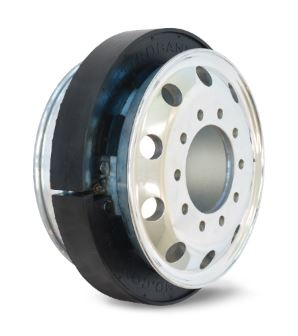- Joined
- Jul 27, 2019
- Messages
- 11,602
- Location
- Midlothian, VA
- RV Year
- 2017
- RV Make
- Newmar
- RV Model
- Ventana 4037
- RV Length
- 40' 10"
- Chassis
- Freightliner XCR
- Engine
- Cummins 400 HP
- TOW/TOAD
- 2017 Chevy Colorado
- Fulltimer
- No
Most of us have heard of Rettrobands by now. If you haven't click the link in the prior sentence to learn more but the gist is that it is a "mini tire" per se inside of your tire typically installed only on steer (front) tires. Almost all of us driving big rigs such as Class A's fear a steer tire blowout and some have lost their lives as a result of such an incident. My understanding is that NIRVC is a co-partner on this product or has acquired it, I don't know but it may be part of why they are so expensive.
And there in lies my problem with Rettrobands, the price. If you've developed a safety device that can save lives then in my opinion it would serve the RV community (or beyond) better by ensuring a wider distribution and make them affordable so EVERYONE can have these on their big rig. As of now they are "exclusively offered by NIRVC" per the website linked above which is problematic. Can NIRVC handle the demand for these and how much does this take away from other RV services needed? Sometimes companies set pricing to control the demand, i.e. high price to keep the demand under control to an acceptable level. But let me say again, is this serving the RV community in saving lives or is this protecting a limited distribution and schedule that only NIRVC can handle? I want to buy new tires and with no one other than NIRVC being able to install these, this drives owners to either buy tires from NIRVC only or having to schedule a visit to NIRVC which I don't know what that backlog entails or will entail in time.
How can this be improved and a wider distribution be offered? Let's take for example Centramatics which I am considering. If you go to the dealer locator you can see who all can install Centramatics (or sell them). Imagine if Rettrobands had the same depth of distribution which could help reduce costs but also SAVE MORE LIVES by getting this safety product to more vehicles. Documentation for installation including, yep, video training, can help train techs on how to install these. It can't be that difficult. Wouldn't it be great if your coach came off the line with Rettrobands installed?
I recently got a quote for Rettrobands for my 305 sized tires and it's $5k. That's 2 x tires (Rettrobands).
My request to NIRVC is to again help save lives, make these affordable, increase distribution to make them more attainable. The "rich" part of getting rich off of a safety product such as this should be in your heart and not in your wallet. Serve thy community and not thy self.
And there in lies my problem with Rettrobands, the price. If you've developed a safety device that can save lives then in my opinion it would serve the RV community (or beyond) better by ensuring a wider distribution and make them affordable so EVERYONE can have these on their big rig. As of now they are "exclusively offered by NIRVC" per the website linked above which is problematic. Can NIRVC handle the demand for these and how much does this take away from other RV services needed? Sometimes companies set pricing to control the demand, i.e. high price to keep the demand under control to an acceptable level. But let me say again, is this serving the RV community in saving lives or is this protecting a limited distribution and schedule that only NIRVC can handle? I want to buy new tires and with no one other than NIRVC being able to install these, this drives owners to either buy tires from NIRVC only or having to schedule a visit to NIRVC which I don't know what that backlog entails or will entail in time.
How can this be improved and a wider distribution be offered? Let's take for example Centramatics which I am considering. If you go to the dealer locator you can see who all can install Centramatics (or sell them). Imagine if Rettrobands had the same depth of distribution which could help reduce costs but also SAVE MORE LIVES by getting this safety product to more vehicles. Documentation for installation including, yep, video training, can help train techs on how to install these. It can't be that difficult. Wouldn't it be great if your coach came off the line with Rettrobands installed?
I recently got a quote for Rettrobands for my 305 sized tires and it's $5k. That's 2 x tires (Rettrobands).
My request to NIRVC is to again help save lives, make these affordable, increase distribution to make them more attainable. The "rich" part of getting rich off of a safety product such as this should be in your heart and not in your wallet. Serve thy community and not thy self.














